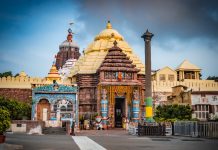Aditi Panda
There is rising awareness to use ecological material & encourage eco friendly Ganesha festival
To decrease the destruction of environment, many devotees and puja committees have started setting up Ganesha idols that are both innovative and eco-friendly. Nowadays the preferred material used is non toxic and colours are biodegradable which neither pollute water nor cause harm to marine life and liquefy effortlessly. The Customary clay was replaced by the lighter and cheaper plaster of Paris to mould the idols. Of late there definitely has been a dramatic demand for ‘green’ idols to celebrate the festival.
The idols worshipped at home are comparatively very small but the devout populace want colossal statues to grab more devotees in Puja pandals due to tough competition and the zeal to win prizes. The immersion of these idols if made from non-biodegradable or toxic materials creates environmental repercussions and pollution perils.
“Most of the Puja committees have reduced the size of the idols and prefer to ornament them with biodegradable, organic colours like turmeric, chandan and gerua. The youth Puja committees have become pro-active and come up with inventive ideas to make the idol with the help of dry spices or even jute threads. Majority of home idols are made of clay and eco-friendly material,” shares Biranchi Majhi, a local artisan.
Taking the cue from the idols around the country it’s interesting to see originality at its best with the local youth getting inspired to try something different. “It was incredible to see idols made with clay but stuffed with fish-friendly food like corn, spinach, wheat and vegetable powder that the fish can eat after immersion. A 190-kg statue of Ganesha using 9 kg of clove, 20 kg of cinnamon, 6 kg of chillies and 1 kg of mustard seeds looked as auspicious as any other idol. Trendy but attractive idols are made using unusual materials like pencils, erasers, chocolates and toy cars. It is encouraging to see the youngsters here also dabble in this new trend,” says Sankalp Mishra, who studied in Pune.
Mumbai artist Dattadri Kothur creates eco-friendly Ganpati idols that are made from red soil, organic fertilisers and plant seeds. At the end of the 10-day festival, the idols undergo a symbolic immersion. Instead of being immersed in a water body, the idol is placed in a complementary pot and watered until it dissolves. The idol grows back as a plant, thanks to the lady finger or Tulsi seeds that are sown in the pot.
The immersion of idols made from non-biodegradable or toxic materials has its environmental repercussions. ‘It hurts to see the deformed parts of our loved god lying on the bank after the immersion as the material stays afloat so precedence should be given to eco friendly material ,’says Shilpa Sharma working with the Railways.
It’s time we follow this trend to celebrate an environment friendly festival with awareness, devotion and enthusiasm.
(Aditi is a freelance writer and pursues interest in the area of social issues)




















Nice one
Thanku for your sincere comments
Its nice to know that both the artisans,the old generation n the youth are veering away from the age old practice of clay Ganesha to the eco-friendly one….Ganpati Bappa Maurya!!!!!
Thanku.Ganapati bappa moryaa
Nice article Aditi.
Thankuuuuuuu
Nicely written Aditi. May the lord Ganesha bless all to celebrate this grand festival with joy & happiness in an eco-friendly way.
Thanks vidya for all your comments
Beautiful article n eco friendly idea.
Thanku so very much for your sincere feedback
It’s highly desirable. People must rise to the occasion.
Totally agree with you.its high time we all take some initiative